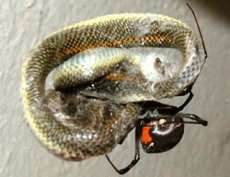 snakes? Yes, not only eagles can catch snakes but spiders as well.
snakes? Yes, not only eagles can catch snakes but spiders as well.
Just like this hapless snake became an Australian redback spider’s lunch last Monday, much to the chagrin of the receptionist who discovered the deadly spider and its prey in their office.
At 14 centimeters in length, the snake is significantly larger than the redback spider, but the deadly arachnid made the kill anyway. The receptionist thinks the snake got caught in the spider’s web Monday night. After receiving its deadly dose of spider poison, the snake was rolled up into a web of its own on Wednesday.
Redback Spider or Latrodectus mactans is a black widow spider and one of the most venomous spiders in the world. It's found throughout the United States, Canada, Mexico and the West Indies. It builds strong retreats close to the ground. However, it also spreads its web over plants. It always need some kind of a shelter and can often be seen in small crevices.







